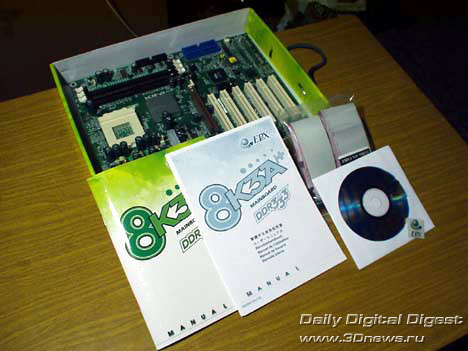As it stands, the board supports good peripheral expansion with 6 bit PCI slots for all the add on cards you might add to your system. Not by much, but measurable. Click to find out more. So we'll take a look at performance from a number of angles. Think about it like that and you see why the figures are so close together.
| Uploader: | Nikogami |
| Date Added: | 16 July 2010 |
| File Size: | 24.51 Mb |
| Operating Systems: | Windows NT/2000/XP/2003/2003/7/8/10 MacOS 10/X |
| Downloads: | 7582 |
| Price: | Free* [*Free Regsitration Required] |
It's quite obvious that Athlon XP could do with a front side bus hike to let it use more memory bandwidth. The ATX case header is also properly labelled, something you don't see on all boards and I was able to connect my case headers without having to refer to the manual which is a nice rarity. DDR memory is happiest running at the same clock as the host bus front side bus so that wait states between the two are minimised.
Performance results So we'll be seeing results from 2 points with our graphs: We've had the board for a little while but we've never been able to make the board work in asynchronous mode and detect any performance increase. The effect isn't pronounced you need a combination of extra bandwidth and an overclocked host bus to take proper advantage of it but the increase does have an effect. However with regular air coolers the socket rotation shouldn't be an issue.
Just how motherboards should be. German etailer lists the systems, based on B motherboards, for early Oct release.
Epox EP-8K3A+ Free Documentation Download (Official)
Think about it like that and you see why the figures are so close together. Not as feature heavy as others but I think that's a good thing for the target audience.
Most focus on the ep-8k3s+ will be in the asynchronous memory mode where you run the board in The floppy and IDE connectors are placed, ideally for this reviewer at least, on the right hand vertical edge of the board and aligned vertically. The board uses a full 9-hole ATX mount and was an easy drop in replacement for the last board in the test chassis.
Like before, a small but appreciable difference in performance is what we are looking for.
Epox EP-8K3A+ KTCE Motherboard Review -
As you can see, running the memory bus at MHz and giving us the extra bandwidth shows us a slight but measureable performance increase. While the BIOS would tell us we were running asynchrously, none of our benchmarks would show us that was the case.
The heatsink does the job fine and remained cool to the touch at all times, even under load. So they developed the 3-phase solution for some of their boards to assist the enthusiast when overclocking and also to provide overall stability at stock speeds.
It's one of the most stable boards I've yet seen, something I maybe couldn't say about EPoX in the past. Sure it leaves some free for the rest of the system to utilise, but by and large the headroom doesn't make much difference. Otherwise layout is identical. Apart from that, the board is quite fully featured. So all the numbers you'll see in this review were garnered using the 8k3a I was a bit hasty in releasing a review ep-8m3a+ the trejber where I could see no discernable difference in the two modes since other reviews had shown a difference and a chat with EPoX UK assured me the board did run asynchronous.
Other manufacturers could take something from EPoX on that point since eep-8k3a+ your motherboard manual isn't hard to imagine. Also, our asynchrous runs show the little increase we need to validate the mode.
Everything from the AGP slot downwards is where it should be. As far as overclocking the board went, large front side bus was easy. Not by much, but measurable. I'm guessing the P80P module is expensive and it doesn't appear on the regular 8K3A for cost reasons. We see that here and it's as we expected.
EPoX EP-8K3A+ - motherboard - ATX - Socket A - KT333 Specs
Given a fast graphics card, you are able to see the effect that memory bandwidth has on the system when you use Quake3. AC'97 audio via the southbridge is also supported however I'm a fan of proper hardware solutions since I've found VIA southbridge provided solutions tend to degrade under high system load whereas a dedicated solution tends not to. The results are higher than any KTA ep-8kk3a+ we've seen, although only by very small amounts which again highlights something we'll touch on in treibrr conclusion so keep reading.
This continues, at least on the motherboard in this review, all the way up to MHz front side bus where it becomes impossible to run asynchronously from the front side bus speed. I'm not a fan of rotated sockets since I used to run water cooling and rotating the socket when moving motherboard meant rotating and repositioning the water block.


No comments:
Post a Comment